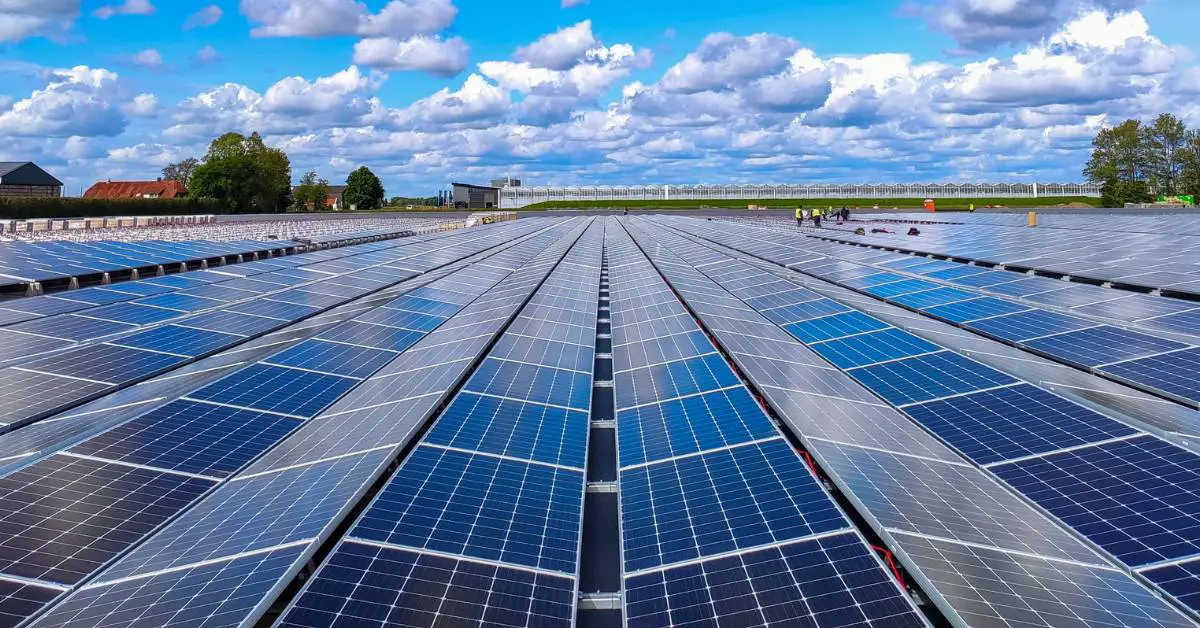Maximizing Savings With Solar Technology
Maximizing Savings With Solar Technology
Are you tired of high energy bills? Do you want to reduce your carbon footprint? Solar technology can help you achieve both of these goals. Solar panels generate electricity from the sun’s energy, which means you can power your home or business with clean, renewable energy. In this article, we’ll explore how you can maximize your savings with solar technology.
Understanding Solar Technology
Solar technology is the process of converting sunlight into electricity. Solar panels are made up of photovoltaic cells that capture the sun’s energy and convert it into electrical energy. This energy can then be used to power your home or business. Solar technology is a clean and renewable energy source that can help reduce your carbon footprint and save you money on energy bills.
Maximizing Efficiency Of Solar Technology
To maximize the efficiency of your solar technology, it’s important to ensure that your solar panels are installed in a location that receives plenty of sunlight. You should also make sure that your solar panels are properly maintained and cleaned regularly. Additionally, you can invest in energy-efficient appliances and devices to further reduce your energy consumption. By taking these steps, you can maximize the efficiency of your solar technology and save even more money on energy bills.
Key Takeaways
- Solar technology is a clean and renewable energy source that can help reduce your carbon footprint and save you money on energy bills.
- To maximize the efficiency of your solar technology, ensure that your solar panels are installed in a location that receives plenty of sunlight, maintain your solar panels properly, and invest in energy-efficient appliances and devices.
- In addition to reducing your energy bills, solar technology can also help you reduce your carbon footprint and contribute to a more sustainable future.
Understanding Solar Technology
Solar technology is the process of capturing and converting energy from the sun into electrical power. Solar panels are the most common form of solar technology and are made up of photovoltaic cells that convert sunlight into direct current (DC) electricity. This electricity is then converted into alternating current (AC) electricity using an inverter, which can be used to power homes, businesses, and other electrical devices.
The most commonly used material for solar panels is crystalline silicon, which is highly efficient and durable. There are two types of crystalline silicon panels: monocrystalline and polycrystalline. Monocrystalline panels are made from a single crystal of silicon and are more efficient than polycrystalline panels, which are made from multiple crystals.
Solar energy is a renewable and sustainable source of power that has many benefits. One of the most significant benefits of solar power is its cost-effectiveness. Solar panels can save you money on your electricity bills and can pay for themselves in just a few years.
Another advantage of solar technology is its environmental impact. Solar energy is clean and produces zero emissions, making it an excellent alternative to traditional fossil fuels. By using solar power, you can reduce your carbon footprint and help protect the environment.
In conclusion, understanding solar technology is essential if you want to maximize savings with solar power. Solar panels, solar energy, solar power, photovoltaics, crystalline silicon, direct current (DC) electricity, alternating current (AC) electricity, and inverters are all critical components of solar technology that you should be familiar with. By harnessing the power of the sun, you can save money, reduce your carbon footprint, and help create a more sustainable future.
The Environmental Impact Of Solar Technology
Solar technology is a clean and renewable energy source that has gained popularity in recent years due to its potential to reduce greenhouse gas emissions and carbon footprint. However, like any other energy source, solar technology has its environmental impacts that need to be considered.
One of the potential environmental impacts of solar technology is land use and habitat loss. Solar panels require a significant amount of land to be installed, which can lead to the destruction of natural habitats and wildlife. However, this impact can be minimized by installing solar panels on already disturbed or degraded lands, such as landfills or brownfields.
Another impact is water use, which can be significant in the manufacturing process of solar panels. However, the water usage of solar technology is significantly lower than traditional energy sources such as coal or nuclear power. Additionally, some solar technologies, such as concentrated solar thermal plants (CSP), require water for cooling, which can be a concern in areas with limited water resources.
The use of hazardous materials in manufacturing solar panels is another potential impact. Some solar panels contain toxic materials such as lead, cadmium, and selenium. However, the amount of these materials used in solar panels is relatively small, and the industry has made significant progress in reducing their use and finding alternatives.
Overall, the environmental impact of solar technology is relatively low compared to traditional energy sources. Solar technology does not emit greenhouse gases or other pollutants during operation, and the environmental impacts associated with manufacturing solar panels can be minimized through responsible sourcing and disposal practices.
In conclusion, solar technology is a promising clean energy source with the potential to reduce greenhouse gas emissions and mitigate climate change. While it has some environmental impacts, these can be minimized through responsible manufacturing and installation practices. By utilizing solar technology, you can reduce your carbon footprint and contribute to a cleaner and more sustainable future.
Maximizing Efficiency Of Solar Technology
One of the main benefits of solar technology is its ability to provide clean and renewable energy. However, to maximize your savings with solar technology, it is essential to ensure that your system is functioning at its highest efficiency. Here are a few things you can do to maximize the efficiency of your solar technology:
Sunlight
The amount of sunlight your solar panels receive is directly proportional to the amount of energy they can produce. Therefore, it is essential to place your solar panels in an area that receives maximum sunlight throughout the day. Trees, buildings, and other obstacles can block sunlight and reduce the efficiency of your solar panels. So, make sure you choose a location that is free from obstructions.
Roof Orientation
The orientation of your roof is another critical factor that affects the efficiency of your solar panels. Ideally, your roof should face south, as this direction receives the most sunlight throughout the day. If your roof faces east or west, you can still install solar panels, but they may not produce as much energy. If your roof faces north, it may not be suitable for solar panels.
Tilt Angle
The tilt angle of your solar panels also affects their efficiency. The ideal tilt angle for solar panels is equal to the latitude of your location. For example, if you live at a latitude of 40 degrees, the ideal tilt angle for your solar panels would be 40 degrees. However, this may not be possible for all roofs. In such cases, you can adjust the tilt angle to maximize the amount of sunlight your panels receive.
Trackers
Solar trackers are devices that allow your solar panels to follow the sun throughout the day. This ensures that your panels receive maximum sunlight, which can increase their efficiency by up to 25%. However, solar trackers can be expensive, and they require additional maintenance.
Conversion Efficiency
Conversion efficiency is the percentage of sunlight that is converted into electricity by your solar panels. The higher the conversion efficiency, the more energy your solar panels can produce. Therefore, it is essential to choose solar panels with high conversion efficiency. Researchers are continually working on improving the conversion efficiency of solar panels through research and development.
By following these tips, you can maximize the efficiency of your solar technology and increase your savings.
Costs & Savings Of Solar Technology
Investing in solar technology can offer significant cost savings in the long run. Although the initial cost of installation can be high, the savings on energy costs and utility bills over time can outweigh the investment.
According to EnergySage, a solar panel system can help you save money by reducing your monthly electricity bills. If you pay $100 per month in electricity now, you’ll pay over $60,000 on electricity over the next 25 years. However, with solar panels, you can potentially save up to $30,000 or more over the same period.
In addition to long-term savings, solar investment can also provide benefits in the short term. The Inflation Reduction Act of 2006 offers a 30% federal tax credit for the cost of installing solar technology. This credit can be used to offset any taxes owed and can be carried forward if not used in the current tax year.
Labor costs for installation can vary depending on the complexity of the project and the location of your home. However, financing options such as solar loans or leasing can help make the investment more affordable. Some solar companies may also offer financing options with no money down and low monthly payments.
It’s important to note that the cost savings of solar technology can vary depending on several factors such as the size of the system, the location of your home, and the amount of sunlight received. However, with advancements in solar technology, prices have been consistently decreasing over time. According to Friend-Pilot, estimated prices for system sizes range from £5,000 to £11,000 in the UK.
Overall, investing in solar technology can be a long-term investment that offers significant cost savings. With financing options and tax credits available, the initial cost of installation can be more manageable. If you’re looking to reduce your energy costs and make a positive impact on the environment, solar technology may be a worthwhile investment for you.
Incentives & Rebates For Solar Technology
If you’re interested in installing solar technology in your home, you’ll be pleased to know that there are many incentives and rebates available to help you offset the cost. These incentives and rebates can make solar technology a more affordable option for homeowners looking to save money on their energy bills.
Tax Credits
One of the most significant incentives available for solar technology is the federal solar investment tax credit (ITC). This tax credit allows homeowners to deduct a percentage of the cost of their solar system from their federal income taxes. As of 2023, the federal ITC is set at 30% of the cost of the solar system. However, this percentage will decrease in the coming years, so it’s important to act quickly if you want to take advantage of this tax credit.
Incentives
Many states, counties, and municipalities offer additional incentives for homeowners who install solar technology. These incentives can include cash rebates, property tax exemptions, and sales tax exemptions. To find out what incentives are available in your area, you can check with your local government or visit the SEIA website.
Net Metering
Net metering is another incentive that can help homeowners save money on their energy bills. Net metering allows homeowners with solar technology to sell excess energy back to the grid. This means that when you generate more energy than you need, you can sell it back to your utility company and receive a credit on your bill. Net metering policies vary by state, so it’s important to check with your local utility company to see if this incentive is available to you.
Rebates
Finally, some utility companies offer rebates for homeowners who install solar technology. These rebates can help offset the cost of the solar system and make it a more affordable option. To find out if your utility company offers rebates for solar technology, you can check with them directly or visit the MarketWatch guide for more information.
In conclusion, there are many incentives and rebates available to help you offset the cost of solar technology. By taking advantage of these incentives, you can make solar technology a more affordable option for your home.
Energy Production & Consumption With Solar Technology
Solar technology can significantly reduce your energy bills by producing clean and renewable energy for your home or business. With solar panels installed on your property, you can generate your own electricity and reduce your reliance on the grid.
The amount of energy that your solar panels can produce depends on factors such as the size of your system, the amount of sunlight your property receives, and the efficiency of your panels. You can maximize your energy production by choosing the right type of solar panels, placing them in the optimal location, and ensuring that they are regularly maintained.
When your solar panels generate more energy than you need, the excess energy is sent back to the grid. This excess energy can be credited to your account and used to offset your energy usage during times when your panels are not producing enough energy. This process is called net metering and can help you save money on your energy bills.
Solar technology can also help you reduce your energy consumption by providing you with real-time data on your energy usage. With this information, you can identify areas where you can reduce your energy usage and increase your energy efficiency. For example, you can adjust your thermostat settings, replace inefficient appliances, and switch to LED light bulbs.
In addition to reducing your energy bills, solar technology can also help you reduce your carbon footprint and contribute to a cleaner environment. By generating your own clean energy, you can reduce the amount of greenhouse gas emissions that are produced by traditional energy sources such as coal and natural gas.
Overall, solar technology provides an effective solution for energy production and consumption. By generating your own clean energy and reducing your energy consumption, you can maximize your energy savings and contribute to a cleaner and more sustainable future.
Solar Technology & The Utility Company
When you install a solar power system, you may still be connected to the utility company’s electrical grid. This means that you can use electricity from the grid when your solar panels aren’t producing enough power, and you can sell excess power back to the grid when your panels produce more than you need.
The size of your solar power system will determine how much electricity it can generate. This is measured in kilowatts (kW). A larger system will generate more electricity, but it will also cost more to install. The size of your system should be based on your energy needs and how much you want to invest.
When you generate excess electricity with your solar power system, you can sell it back to the utility company. This is called net metering. The utility company will credit your account for the excess electricity you generate, which can help offset your electricity costs.
Utility companies typically charge fees to solar-powered homes or businesses that connect to the electrical grid. These fees are designed to cover the cost of maintaining the grid and ensuring that everyone has access to reliable electricity. However, some utility companies offer incentives for installing solar power systems, such as rebates or special rates for solar customers.
It’s important to understand the rules and regulations related to solar power and the utility company in your area. Some states have specific net metering laws that require utility companies to credit solar customers for excess electricity, while others do not. Additionally, the rules regarding how much you can sell back to the grid and at what rate can vary.
Overall, solar power can be a great way to save money on your electricity bills and reduce your carbon footprint. By understanding how solar power works with the utility company, you can make informed decisions about the size of your system and how to maximize your savings.
Storage & Automation In Solar Technology
When it comes to maximizing savings with solar technology, storage and automation are two key components that can greatly enhance the effectiveness of your solar panels. By incorporating battery storage into your solar system, you can store excess energy generated during the day and use it during peak hours when electricity rates are highest. This can result in significant savings on your monthly energy bills.
In addition to battery storage, automation can also play a crucial role in optimizing your solar system’s performance. Automated systems can monitor your energy usage patterns and adjust your solar panel output accordingly, ensuring that you are always generating the optimal amount of energy for your needs. This can help to further reduce your energy costs and maximize your savings over time.
One of the main benefits of battery storage is that it allows you to take advantage of time-of-use pricing. This pricing model charges different rates for electricity depending on the time of day, with peak hours being the most expensive. By storing excess energy during off-peak hours and using it during peak hours, you can significantly reduce your energy costs.
Another benefit of battery storage is that it provides a backup power source in the event of a power outage. This can be particularly useful for homes and businesses located in areas with unreliable power grids. By having a backup power source, you can ensure that your essential appliances and equipment stay up and running even during extended power outages.
Automation is also a key component of maximizing savings with solar technology. Automated systems can monitor your energy usage patterns and adjust your solar panel output accordingly, ensuring that you are always generating the optimal amount of energy for your needs. This can help to further reduce your energy costs and maximize your savings over time.
Overall, incorporating battery storage and automation into your solar system can greatly enhance its effectiveness and help you maximize your savings over time. By taking advantage of time-of-use pricing and ensuring that your solar panels are always generating the optimal amount of energy for your needs, you can significantly reduce your energy costs and enjoy the many benefits of solar technology.
Solar Technology In Different Locations & Markets
Solar technology has become an increasingly popular choice for renewable energy sources in different locations and markets. The National Renewable Energy Laboratory (NREL) in the United States has reported that solar energy is the fastest-growing source of renewable energy in the country, with the potential to provide more than 100 times the country’s current electricity needs.
In different locations, the availability of sunlight and the climate can affect the efficiency of solar panels. For example, in areas with high levels of sunlight, such as the southwestern United States, solar panels can generate more energy than in areas with less sunlight. However, solar technology can still be a viable option in areas with lower levels of sunlight, as advancements in technology have increased the efficiency of solar panels.
In different markets, the cost of solar technology can vary depending on factors such as government incentives, tax credits, and subsidies. For example, in the United States, the federal government provides tax credits for homeowners and businesses that install solar panels, which can help offset the upfront cost of installation. In addition, some states and local governments offer additional incentives, such as rebates and net metering programs, which allow homeowners and businesses to sell excess energy back to the grid.
Solar technology can also be used in different ways, such as in residential, commercial, and industrial settings. In residential settings, solar panels can be installed on rooftops to provide electricity for homes. In commercial and industrial settings, solar panels can be installed on buildings or in large solar farms to provide electricity for businesses and communities.
In conclusion, solar technology has become an increasingly popular choice for renewable energy sources in different locations and markets. The availability of sunlight, government incentives, and advancements in technology have made solar technology a viable option for homeowners, businesses, and communities.
Solar Technology Vs Traditional Energy Sources
When it comes to powering your home or business, there are two main options: traditional energy sources or solar technology. Traditional energy sources include fossil fuels like coal, oil, and natural gas. Solar technology, on the other hand, harnesses the power of the sun to generate electricity. In this section, we’ll compare and contrast these two options to help you make an informed decision about which one is right for you.
Cost
One of the biggest advantages of solar technology is its cost-effectiveness. While the initial investment in solar panels can be high, the long-term savings are significant. Solar panels have a lifespan of around 25 years and require very little maintenance, which means you’ll save money on energy bills for years to come. Traditional energy sources, on the other hand, are subject to price fluctuations and can be impacted by geopolitical events that affect the energy sector.
Environmental Impact
Solar technology is a clean, renewable energy source that produces no emissions or pollution. This means it’s better for the environment than traditional energy sources, which can have a significant impact on air and water quality. Additionally, solar technology can help reduce our dependence on foreign oil and increase energy independence.
Reliability
While solar technology has come a long way in recent years, it still has some limitations. For example, solar panels are dependent on sunlight, which means they may not be as reliable in areas with limited sunlight or during periods of inclement weather. Traditional energy sources, on the other hand, are generally more reliable and can provide power even during power outages.
Conclusion
When it comes to choosing between solar technology and traditional energy sources, there are a lot of factors to consider. Ultimately, the decision will depend on your individual needs and circumstances. If you’re looking for a cost-effective, environmentally friendly energy source that can help increase energy independence, solar technology may be the right choice for you. However, if reliability is a top priority, traditional energy sources may be a better option.
Maintenance & Convenience Of Solar Technology
Maintaining your solar technology is crucial to ensure optimal performance and maximize savings. Regular system maintenance, including cleaning solar panels, inspecting for any damage or debris, and monitoring system performance, is essential to keep your solar power system functioning at its best.
Cleaning your solar panels is an important maintenance task that should be done periodically to remove any dust, debris, or other environmental factors that can accumulate on your panels, reducing their efficiency. You can either clean the panels yourself or hire a professional solar maintenance company to do it for you. The cost of cleaning panels typically ranges from $15 to $35 per panel, depending on the company and location.
Inspecting your solar panels for any damage or debris is also important to ensure that your system is functioning properly. If you notice any damage or debris, it is recommended that you contact a professional to have it repaired or removed.
Monitoring your system’s performance is another important maintenance task that you should do regularly. By monitoring your system’s energy production, you can identify any issues or inefficiencies and take corrective action to optimize your savings.
Solar technology offers many conveniences, including the ability to generate your own electricity and reduce your reliance on the grid. With a solar power system, you can produce your own electricity directly from the sun, which means that you are not dependent on the utility company for your energy needs.
Additionally, solar power systems can produce both direct current (DC) and alternating current (AC), which makes them versatile and convenient. DC is the type of electricity produced by solar panels, while AC is the type of electricity used in most homes and businesses. Solar power systems convert DC to AC using an inverter, which allows you to use the electricity produced by your solar panels to power your home or business.
In summary, maintaining your solar technology is crucial to ensure optimal performance and maximize savings. Regular system maintenance, including cleaning solar panels, inspecting for any damage or debris, and monitoring system performance, is essential to keep your solar power system functioning at its best. Solar technology also offers many conveniences, including the ability to generate your own electricity and produce both DC and AC electricity.
Financial Well-being With Solar Technology
Investing in solar technology can have a significant impact on your financial well-being. By generating your own electricity, you can reduce your reliance on the grid and lower your energy bills. Additionally, you may be eligible for tax credits and incentives that can further reduce the cost of installation.
Here are some ways that solar technology can improve your financial well-being:
Lower Energy Bills
One of the most significant benefits of solar technology is the ability to generate your own electricity. By doing so, you can reduce your reliance on the grid and lower your energy bills. The amount of savings will depend on a variety of factors, such as the size of your system, your energy usage, and the cost of electricity in your area.
Tax Credits & Incentives
In addition to lower energy bills, you may also be eligible for tax credits and incentives that can further reduce the cost of installation. For example, the federal government offers a tax credit of up to 30% of the cost of installation. Some states and local governments also offer incentives, such as rebates and grants, to encourage the use of solar technology.
Increased Home Value
Investing in solar technology can also increase the value of your home. According to a study by the National Renewable Energy Laboratory, homes with solar panels sell for an average of 4.1% more than homes without them. This means that not only can you save money on energy bills, but you can also potentially make a profit if you decide to sell your home in the future.
Environmental Benefits
Finally, investing in solar technology can have a positive impact on the environment. By generating your own electricity, you can reduce your carbon footprint and help mitigate the effects of climate change. This can have long-term benefits for both the planet and your financial well-being.
In summary, solar technology can have a significant impact on your financial well-being by reducing your energy bills, providing tax credits and incentives, increasing the value of your home, and having a positive impact on the environment.
Frequently Asked Questions
How can I calculate my potential savings with solar technology?
Calculating your potential savings with solar technology depends on several factors, including your location, the size of your solar panel system, and your current energy usage. There are online calculators available, such as the one provided by EnergySage, that can help estimate your potential savings. However, it’s important to keep in mind that these are just estimates and your actual savings may vary.
What factors impact the amount of money I can save with solar?
Several factors impact the amount of money you can save with solar, including the size of your solar panel system, your energy usage, the cost of electricity in your area, and the amount of sunlight your location receives. Additionally, the type of solar panel technology you choose and the quality of the installation can also impact your savings.
What is the average payback period for solar panel installation?
The average payback period for solar panel installation varies depending on several factors, including your location, the size of your solar panel system, and your current energy usage. Generally, the payback period for solar panel installation ranges from 5 to 10 years. However, with the help of government incentives and rebates, the payback period can be reduced even further.
Are there any government incentives or rebates available for solar installation?
Yes, there are several government incentives and rebates available for solar installation. For example, in the United States, the federal government offers a tax credit of up to 26% of the cost of solar panel installation. Additionally, many states and local governments offer their own incentive programs, such as rebates or tax credits, to encourage the installation of solar technology.
What are some common mistakes to avoid when trying to maximize solar savings?
Some common mistakes to avoid when trying to maximize solar savings include installing a system that is too small for your energy needs, failing to properly maintain your system, and not taking advantage of government incentives and rebates. Additionally, it’s important to choose a reputable installer and high-quality equipment to ensure the longevity and efficiency of your system.
Can adding a heat pump system to my solar setup increase my savings?
Yes, adding a heat pump system to your solar setup can increase your savings by allowing you to heat and cool your home using the energy generated by your solar panels. Heat pumps are highly efficient and can help reduce your reliance on traditional heating and cooling systems, which can be costly to operate.








